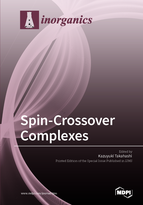Spin-Crossover Complexes
A special issue of Inorganics (ISSN 2304-6740). This special issue belongs to the section "Coordination Chemistry".
Deadline for manuscript submissions: closed (31 July 2017) | Viewed by 78742
Special Issue Editor
Interests: functional molecular materials; molecular conductors; molecular magnets; molecular dielectrics; molecular optical materials; spin-crossover; valence tautomerism; thermo- and photochromism; photoluminescence; chrage-transfer; proton-transfer; phase transition; crystal engineering
Special Issues, Collections and Topics in MDPI journals
Special Issue Information
Dear Colleagues,
Spin-crossover (SCO) phenomenon is originated from the intrinsic bistability of the d-electron configuration, created by the competition between ligand-field splitting and spin-pairing energies in a first coordination sphere of transition metal ions. Since Cambi’s visionary finding of SCO in 1931, considerable knowledge concerning syntheses, crystal structures, magnetic and thermodynamic properties, spectroscopies, molecular orbital calculations, and theories of SCO complexes has been accumulated in a very large number of inorganic molecular coordination compounds, and, in addition, inorganic cobaltates and bioinorganic molecular systems. Recent studies which have focused on other electronic properties exhibited by SCO complexes themselves, control of molecular assemblies, and moreover, multifunctionalization of SCO complexes with either different electronic properties or porous frameworks will open the possibility toward future practical applications of SCO complexes. Thus, the fundamentals and applications of SCO complexes afford a very exciting research field in inorganic coordination chemistry and will be attracting growing attention in a wide range of relevant research fields. This Special Issue aims at collecting research and review contributions of recent advances in all aspects of SCO and related phenomena and sharing given extensive knowledge with a broader audience by means of an open access way. I invite you to contribute papers in the following research areas and allow your research to impact the next generation trend in this promising field.
Kazuyuki Takahashi
Guest Editor
Manuscript Submission Information
Manuscripts should be submitted online at www.mdpi.com by registering and logging in to this website. Once you are registered, click here to go to the submission form. Manuscripts can be submitted until the deadline. All submissions that pass pre-check are peer-reviewed. Accepted papers will be published continuously in the journal (as soon as accepted) and will be listed together on the special issue website. Research articles, review articles as well as short communications are invited. For planned papers, a title and short abstract (about 100 words) can be sent to the Editorial Office for announcement on this website.
Submitted manuscripts should not have been published previously, nor be under consideration for publication elsewhere (except conference proceedings papers). All manuscripts are thoroughly refereed through a single-blind peer-review process. A guide for authors and other relevant information for submission of manuscripts is available on the Instructions for Authors page. Inorganics is an international peer-reviewed open access monthly journal published by MDPI.
Please visit the Instructions for Authors page before submitting a manuscript. The Article Processing Charge (APC) for publication in this open access journal is 2700 CHF (Swiss Francs). Submitted papers should be well formatted and use good English. Authors may use MDPI's English editing service prior to publication or during author revisions.
Keywords
- Spin-Crossover (SCO)
- Valence Tautomerism
- Charge-transfer-induced Spin Transition
- Stimulus-induced Spin Transition
- Ligand-driven Spin-state Conversion
- Multifunctionality of SCO and related complexes
- Crystal Engineering of SCO and related complexes






